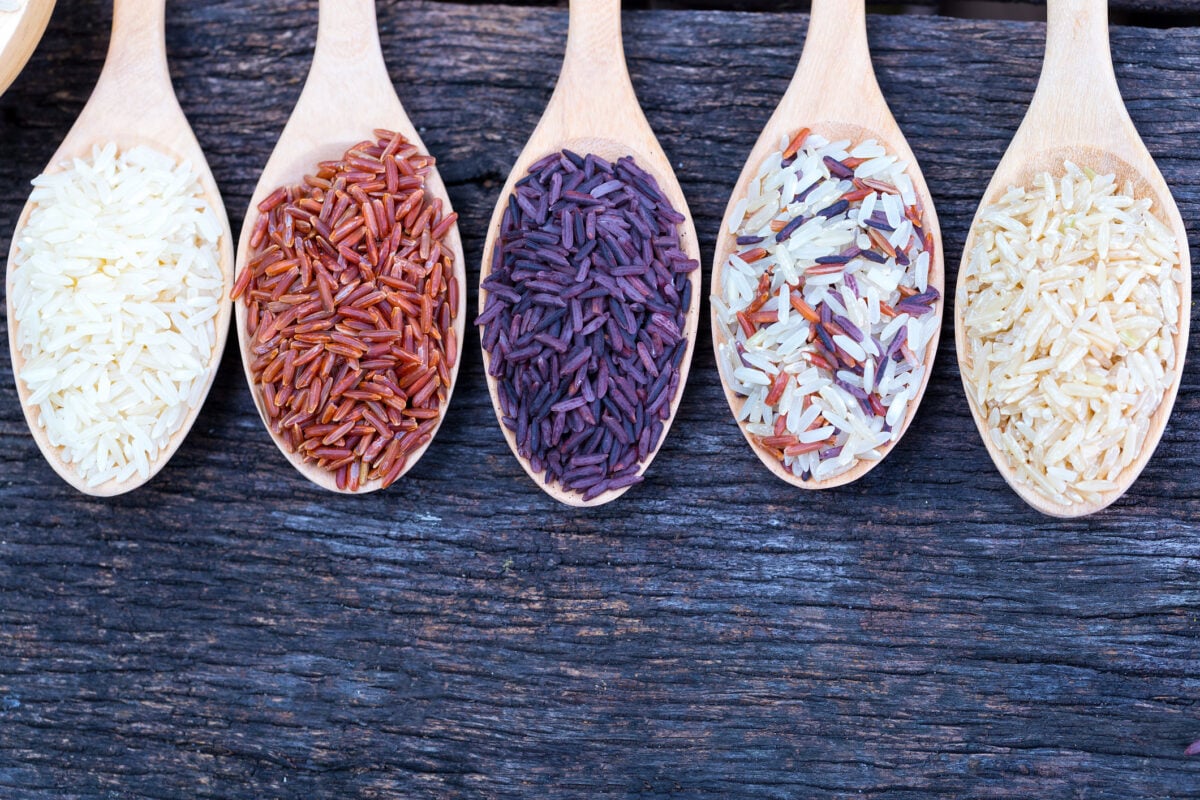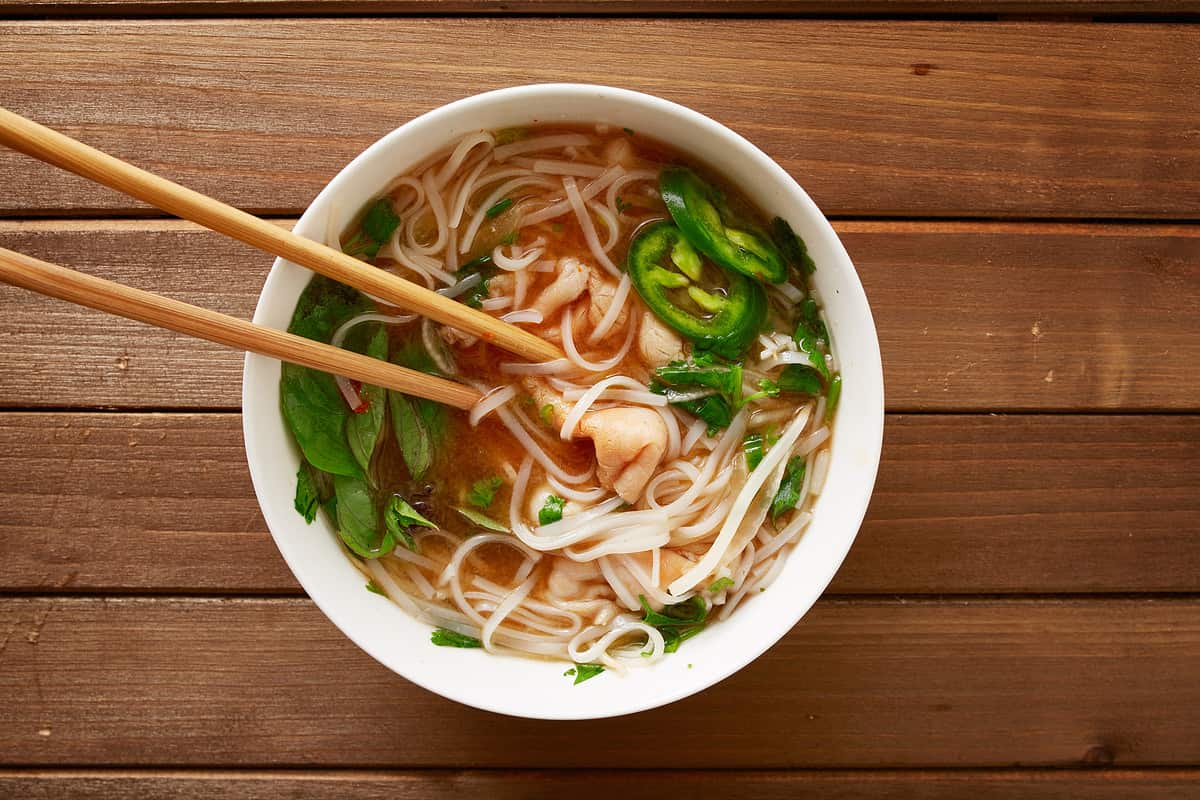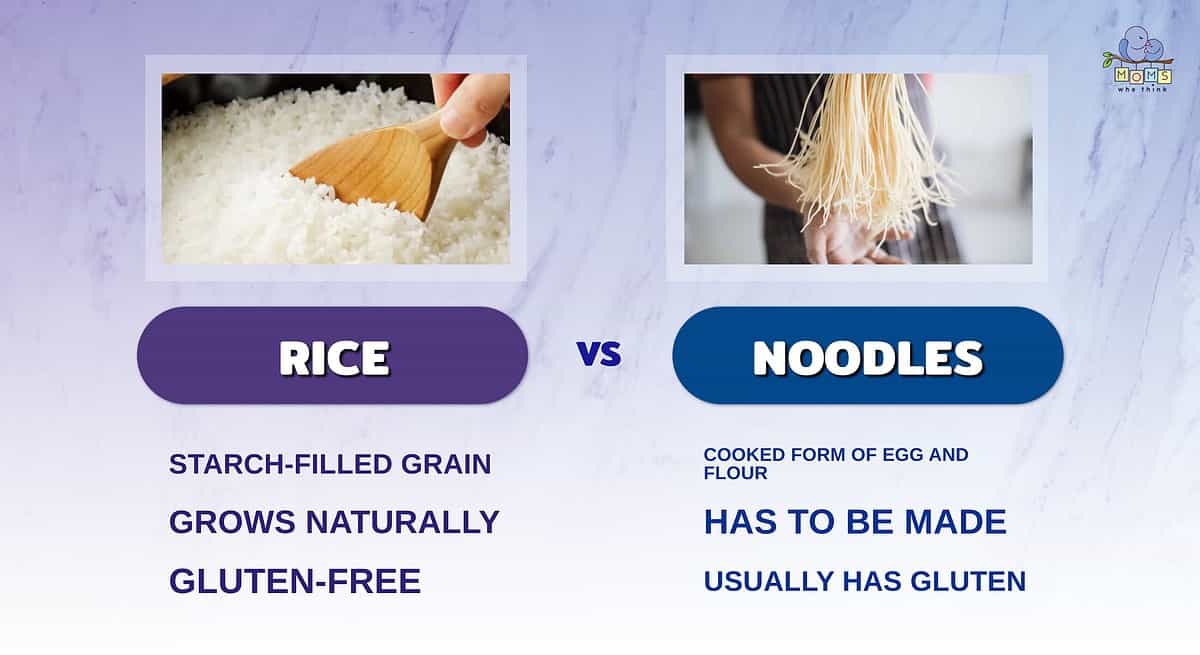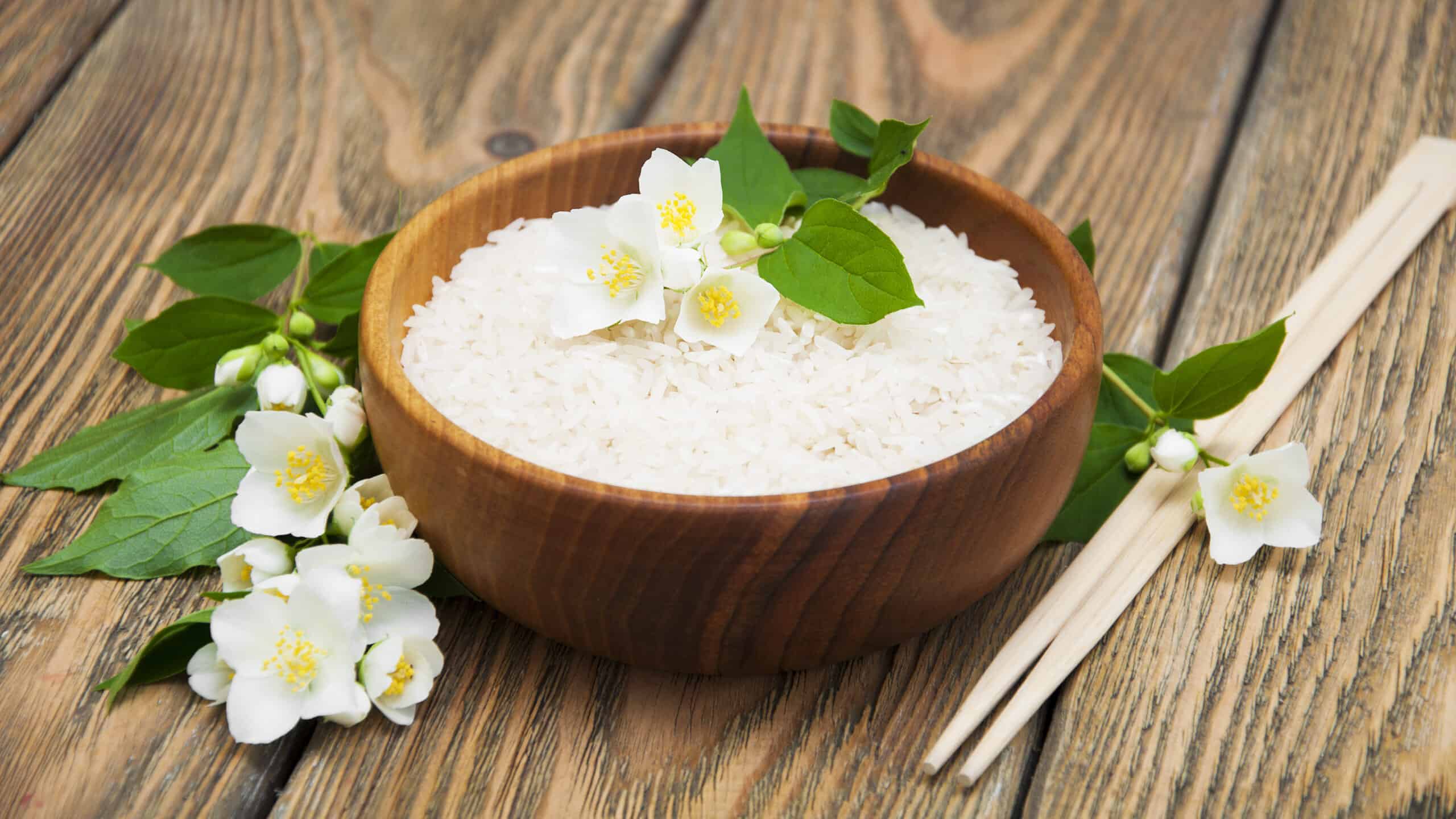Picture this: it’s dinner time and you’re deciding on rice vs. noodles. But what is the difference? Obviously, they’re separate products, but physical differences aside, they serve similar roles in many kinds of meals. Add rice and/or noodles to liven up stews, soups, and broths. Or cook them plain and add some sauce or butter. They’re easy to make and a quick meal to prepare. There are many kinds of rice, and noodles come in all shapes, sizes, and ingredients. So, where is the line and what is the difference in the grand debate of rice vs. noodles?
In this post, we’ll take a look at these carbohydrates’ historical ties and use in modern recipes. You’ll learn about the kinds of rice and noodles available to you. And you might get inspired to try some new dishes once you’re finished reading. Now, let’s get into the details of rice vs. noodles.
Rice vs. Noodles: How Are They Different?
Rice is a grain and noodles can be formed from rice grains. However, the two have quite different textures, appearances, and nutritional profiles. Their taste is comparable. They are used in a variety of different dishes, both separately and together. Rice is a great base for veggies, proteins, and sauces and so are noodles. Both rice and noodles can provide healthy carbohydrates, protein, fiber, and calories. They have many similarities in application. However, their differences are important to know because sometimes you'll want to use rice instead of noodles or vice versa.
What is Rice?
Rice is a starch-filled cereal grain. Rice grows from grass plants that need lots and lots of water. They are harvested from fields called rice paddy fields. According to Brittanica, almost half the world's population depends on rice as a staple in their diets. The most common way to eat this grain is to boil it and serve it hot. Grind it into flour and you can use it for baking! There are a also number of alcoholic drinks that use fermented rice as their base, including Sake, which originates from Japan.
History, Origin, and Varieties
Rice is a hard grain to date. But there are reports of rice grain going back to 2800 BC in parts of China. And then, somehow, rice made its way to the U.S. Some theories suggest it traveled on a British ship bound in 1694 that was headed for Madagascar. From trade routes and travelers, these grains were cultivated throughout Sri Lanka and India. Eventually, they spread through Greece, the Mediterranean, Southern Europe, and North Africa. Rice's ability to grow in numerous climates has made it the staple food of many cultures. Rice is used in ceremonies (wedding rice, anyone?) and in folklore, with many tales of its fertility and bountiful gifts.
There are some 120,000 kinds of rice. These rice variations can be used in different dishes and come in many colors. Rice size is categorized as long-grain, medium-grain, and short-grain. This has to do with the length of the grain. Types of rice are also categorized by their starch content, flavor and ability to be milled into flour. While there is also a variety of grain called “Wild rice.” However, Wild rice is actually a semi-aquatic grass plant that produces grains, not a true rice plant.

©iStock.com/A stockphoto
How to Cook Rice
The easiest way to cook rice is with a rice cooker. Simply plug it in, put in your rice, and turn on the timer. And that's all you need for this handy machine to do its job. However, if you're looking to do it the way that people have been making rice for thousands of years, you'll need a pot, some water, and some heat.
The New York Times recipe recommends washing the starch from your rice until the water runs clear in the pot. The ratio of rice to water is typically 1 cup to 1 cup. This ratio may change depending on the grain type you are cooking. Bring the rice and water to a boil. Be sure to stir to ensure there's no rice burning on the bottom of the pan. Next, you'll cover the pot with a lid and let the rice cook on low. Long and medium-grain varieties can be cooked for 15 minutes, while short-grain needs about 20 minutes. Brown rice, because the outer layer of the grain, or the bran, hasn't been removed, will take the longest at around 30 minutes of cooking time (via The Food Network).
Nutritional Value
Rice has many health benefits. Not only is it gluten-free, nutrient-rich, and good for your heart, but it packs a punch of serotonin and can help to boost your energy. The USDA breaks down a cup of cooked white, long-grain rice as follows. There are about 0.4 grams of total fat, 0.1 gram of saturated fat, 206 calories, 0.6 grams of dietary fiber, 0.1 grams of sugar, and 4.3 grams of protein. That same cup of rice has around 2 milligrams of sodium, 55 milligrams of potassium, and vitamins and minerals like calcium, iron, magnesium, and vitamin B. A cup of brown rice differs slightly with increased calorie and protein content, and a higher vitamin B6 and magnesium percentage (via USDA).
Popular Uses
Rice is popular in all kinds of meals across all kinds of cultures. You'll find short-grain white rice in sushi rolls, long and medium grains in Spanish paella dishes, and in all kinds of soups. It can be a great base for proteins. Try rice in a mushroom risotto or as the base for a Buddha bowl. Throw it into a casserole, eat it fried with vegetables, or have it as part of a cold and refreshing salad. There are simply so many ways to use and consume rice, which is why it is a primary food staple for people all over the world!
What Are Noodles?
Noodles are a cooked form of egg and flour that has been shaped into a long and edible ribbon. They are different than pasta because noodles are formed differently and made from lots of different bases including rice, tapioca, mung beans, root veggies, and even seaweed! Noodles are prominent in soups, broths, hot and cold salads, stir-fries, and more. They vary in texture and color, depending on their base ingredients, and can be made fresh for cooking or dried and preserved. Let's get into the details.
History, Origin, and Kinds
Historical mentions of noodles date back to China in the 3rd century A.D. Noodles also cropped up in Jerusalem in the 5th century A.D. and in Syrian recipes only a few centuries later. The silk road trade routes helped in the spread of these recipes and Asian countries began to further develop and evolve the types of noodles for sale on the street and in restaurants (via The Atlantic). In the 1930s, the prime minister of Thailand ruled that Pad Thai, which used rice noodles, would be the national dish. This action further cemented the tie between noodles and Asian cuisine. During World Wars, turning the shortage of rice grain into noodles helped lots of people use their grain flour for twice as long.
Modern-day, there are all kinds of noodles that have evolved from early recipes. Popular noodles include Japanese udon noodles, Low Mein and Chao Mein, ramen, glass noodles, soba noodles, and flat rice noodles. Some of these are made from rice, others from tapioca or sweet potato starch (via Spruce Eats). The noodles made from wheat have some crossover with Italian pasta-making techniques.

©iStock.com/rez-art
How to Cook Noodles
Like rice, noodles are quite easy to cook. Simply put them in some boiling water and check on them until they're ready to be strained out. Noodles from certain flour types will cook quite fast, so be sure you're watching them. Remove them from the water while they're al dente (slightly underdone). This will help to ensure you don't get a sticky mess. Other types of noodles hold up quite well in broths and other mixtures. For instance, you can cook ramen alongside proteins, veggies, and other garnishings to produce a hearty, flavorful broth. Research the ingredients and you'll know the best way to cook with a particular type of noodle dish!
Nutritional Value
The nutritional value of noodles is dependent on the dish that is cooked. It matters what they're cooked with and the type of flour that is used. Healthline breaks down the nutritional value of a pack of beef-flavored instant noodles as follows. There are about 188 calories, 7 grams of fat, 27 grams of carbohydrates, 3 grams of saturated fat, 4 grams of protein, and 0.9 grams of fiber. Vitamins and minerals include amounts of thiamine, folate, manganese, iron, niacin, and riboflavin. On the downside, a pack of instant ramen can be really high in sodium, with this one clocking at 861 milligrams. If you were to make your ramen at home or substitute salt for low-sodium ingredients, you'd be able to decrease the sodium count!
Popular Uses
Noodles can be used in all kinds of dishes. From soups and broths, like ramen or udon, to seafood stir-fries, or casseroles, you really can't go wrong! Vermicelli noodles are used in spring rolls, paired with sauces, meats, or veggies. Pad Thai, Lo Mein, or Dan Dan noodles are all traditional noodle dishes that are well worth the try of making at home.
Possible Alternatives to Rice and Noodles
Rice can be replaced by other grains. Try out quinoa or cauliflower rice, chickpeas, bulgar, barley, or farro. As for noodles, since some common types are made from wheat flour, just like pasta, it means that pasta is an easy substitute for certain noodle dishes. There are also many types of non-wheat pasta, made from many of the rice alternatives listed above!
Rice vs. Noodles: Are They The Same Thing?

- Rice is a starch-filled grain, while noodles consist of egg and flour that has been cooked.
- Noodles have to be made; they can't be grown! Rice, on the other hand, is grown and then harvested.
- Rice is naturally gluten-free. Pasta traditionally contains gluten, but some varieties use different ingredients to make the noodles gluten-free.
In conclusion of the great rice vs. noodles debate, no, they are not the same thing. However, they very much interact as one can be milled from the other and rice can be swapped out for noodles, just as noodles can be swapped out for rice. Their versatility makes them a great base for most styles of cooking and the ease at which they can be cooked has cemented them as a dietary staple for many people around the globe. No wonder these ingredients and recipes have been around for thousands of years!
In the mood for a great rice recipe? Check out this amazing chicken fried rice recipe from Moms Who Think:
PrintChicken Fried Rice
- Yield: 4 servings 1x
Ingredients
2 egg whites
1 egg
½ teaspoon salt, divided
1 small onion, chopped
1 garlic clove, minced
1 cup frozen mixed vegetables
2 cups diced cooked chicken breast (rotisserie chicken works well)
3 Tablespoons reduced sodium soy sauce
3 cups cold cooked brown rice
Instructions
1. In a small bowl, combine the egg whites, egg, and ¼ teaspoon salt. In a large nonstick skillet or wok coated with cooking spray, cook the egg mixture over medium heat. As eggs set, lift edges, letting uncooked portion flow underneath. When the eggs are set, remove, and cut into 1 inch pieces; keep warm.
2. In the same pan, stir fry the onion and garlic until tender.
3. Add vegetables; cover and cook over medium high heat for 3 to 4 minutes or until no longer frozen.
4. Stir in the chicken, soy sauce, and remaining ¼ teaspoon salt; cook for 1 minute.
5. Add rice; stir fry for 4 to 5 minutes or until heated through. Add eggs; heat through.
Nutrition
- Serving Size: 1.25 cups
- Calories: 325
- Sodium: 854mg
- Fat: 4g
- Saturated Fat: 1g
- Carbohydrates: 41g
- Fiber: 2g
- Protein: 29g
- Cholesterol: 107mg
The image featured at the top of this post is ©Zb89V/Shutterstock.com.


